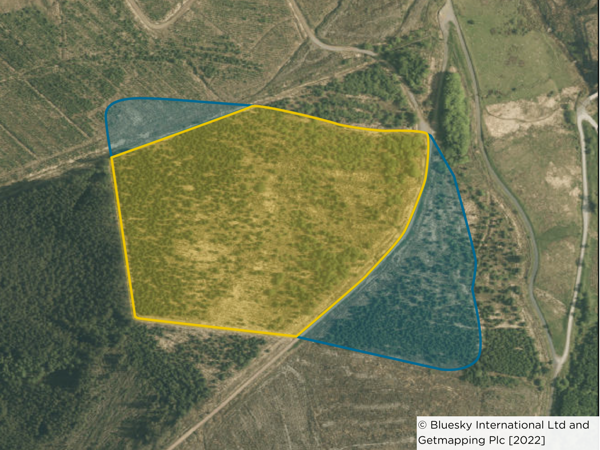Work finishes to protect a Roman Marching Camp that ‘tells the story of the Roman Conquest of Wales’

Work to protect the remains of a Roman Marching Camp near Ystradfellte has been finished by contactors working on behalf Natural Resources Wales.
- The yellow area in the image denotes the site and boundaries that were worked on to preserve the scheduled monument.
- The blue area in the image denotes areas of the Roman Marching Camp which are too damaged to be worked.
The camp is thought to have been used by the Romans during the conquest of Wales in the first century AD and is listed as a scheduled monument.
Remains of the earth boundary banks and ditch of the camp have been preserved by NRW as part of their duty to protect important historical features under the UK Woodland Assurance Standard.
The recent work to preserve the remains involved removing tree growth using a flail mounted on an excavator. The excavator itself moved using extra-wide floatation tracks to reduce ground pressure. These tracks reduced the impact of the work on the protected site, but also allowed the heavy excavator to work on the wet ground.
Paul Dann, Land Management Team Leader for Natural Resources Wales said:
“Managing woodland sustainably is much more than what people usually think. We need to make sure that we produce quality timber and protect biodiversity, but we also need to protect the cultural and historical features on the land that we manage.
“This means treating some parts of land differently. This could include simply not planting on the land or removing growth that will damage the historical feature. We work closely with Cadw to make sure that we approach the preservation of each ancient monument in the right way.
“Many scheduled monuments have been worn down over centuries, and might not be obvious to passers-by, but they are important pieces of our collective history and need to be preserved wherever possible.”

Amelia Pannett, Field Monument Warden for Cadw, the Welsh Government's historic environment service said:
“We work closely with NRW officers across Wales to make sure that the scheduled monuments on the land they manage are preserved for future generations.
“In this case, we worked with NRW to produce an agreed management plan for the marching camp scheduled monument, and we advised them on how to carry out the work without damaging the historical value on site.
“This camp helps tell the story of the Roman conquest of Wales. While marching across the country, the Romans built these camps as temporary structures to protect themselves from attack, and as a base for their activities for no more than a couple of weeks.
“It is amazing that parts of a temporary structure can be appreciated roughly 2,000 years later.”
